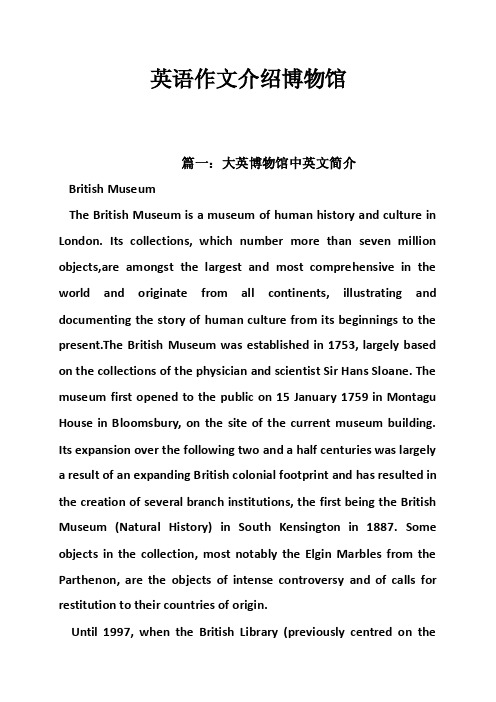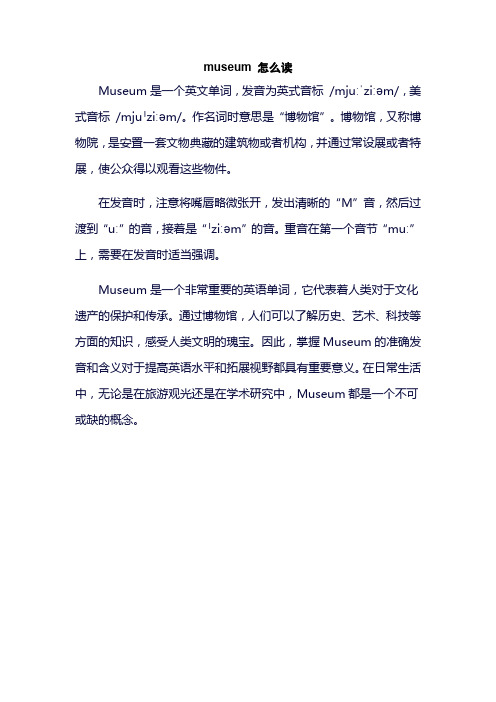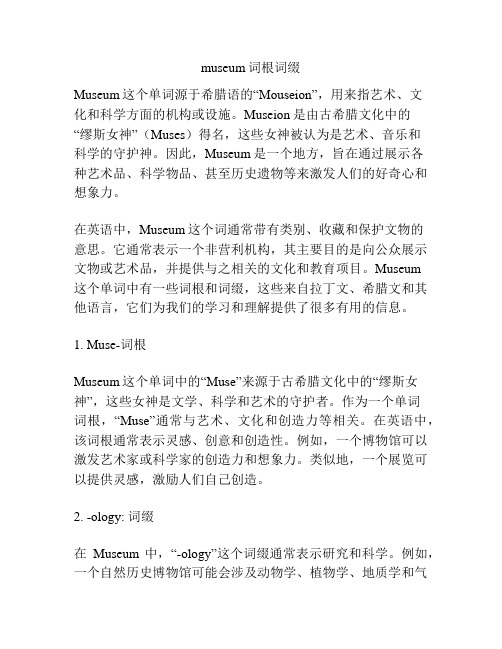英语 museum
英语作文介绍博物馆

英语作文介绍博物馆篇一:大英博物馆中英文简介British MuseumThe British Museum is a museum of human history and culture in London. Its collections, which number more than seven million objects,are amongst the largest and most comprehensive in the world and originate from all continents, illustrating and documenting the story of human culture from its beginnings to the present.The British Museum was established in 1753, largely based on the collections of the physician and scientist Sir Hans Sloane. The museum first opened to the public on 15 January 1759 in Montagu House in Bloomsbury, on the site of the current museum building. Its expansion over the following two and a half centuries was largely a result of an expanding British colonial footprint and has resulted in the creation of several branch institutions, the first being the British Museum (Natural History) in South Kensington in 1887. Some objects in the collection, most notably the Elgin Marbles from the Parthenon, are the objects of intense controversy and of calls for restitution to their countries of origin.Until 1997, when the British Library (previously centred on theRound Reading Room) moved to a new site, the British Museum was unique in that it housed both a national museum of antiquities and a national library in the same building. The museum is a non-departmental public body sponsored by the Department for Culture, Media and Sport, and as with all other national museums in the United Kingdom it charges no admission fee. Since 2002 the director of the museum has been Neil MacGregor.HistorySir Hans Sloane, founder of the British MuseumAlthough principally a museum of cultural art objects and antiquities today, the British Museum was founded as a "universal museum". Its foundations lie in the will of the physician and naturalist Sir Hans Sloane (1660–1753). During the course of his lifetime Sloane gathered an enviable collection of curiosities and, not wishing to see his collection broken up after death, he bequeathed it to King George II, for the nation, for the princely sum of £20,000.At that time, Sloane’s collection consisted of around 71,000 objects of all kinds[8] including some 40,000 printed books, 7,000 manuscripts, extensive natural history specimens including 337 volumes of dried plants, prints and drawings including those by Albrecht Dürer and antiquities from Egypt, Greece, Rome, theAncient Near and Far East and the Americas.Foundation (1753)On 7 June 1753, King George II gave his formal assent to the Act of Parliament which established the British Museum.The Foundation Act, added two other libraries to the Sloane collection. The Cottonian Library, assembled by Sir Robert Cotton, dated back to Elizabethan times and the Harleian library, the collection of the Earls of Oxford. They were joined in 1757 by the Royal Library, assembled by various British monarchs. Together these four "foundation collectionsincluded many of the most treasured books now in the British Library including the Lindisfarne Gospels and the sole surviving copy of Beowulf.The British Museum was the first of a new kind of museum –national, belonging to neither church nor king, freely open to the public and aiming to collect everything. Sloane's collection, whilst including a vast miscellany of objects, tended to reflect his scientific interests. The addition of the Cotton and Harley manuscripts introduced a literary and antiquarian element and meant that the British Museum now became both national museum and library.大英博物馆(British Museum)又称不列颠博物馆,是一位于英国伦敦的综合博物馆,也是世界上规模最大、最著名的博物馆之一,成立于1753年。
博物馆的英文单词

博物馆的英文单词博物馆是征集、典藏、陈列和研究代表自然和人类文化遗产的实物的场所。
你知道博物馆的的英文单词是什么吗?现在跟店铺一起学习关于博物馆的英语知识吧。
博物馆的英文释义museummuaeumrepository博物馆的英文例句参观博物馆被推迟了。
Our visit to the museum is postponed.此诗现存最早的原稿收藏在这座博物馆里。
The earliest extant manuscript of this poem has been kept in the museum.这个博物馆里不准使用闪光灯。
Flashes are not allowed to be used in this museum.这个博物馆展出中国古瓷器标本。
The museum displays the specimen of ancient Chinese porcelain.该博物馆收藏了很多极其古老的文物。
The museum has many immemorial cultural relics.这家博物馆收藏了许多艺术珍品。
This museum has many art treasures.为满足需求,北京将兴建新博物馆并装修现有的博物馆。
Capital set to build new venues and update old ones in bid to satisfy demand.广场西侧有历史博物馆和自然博物馆。
The square west side has the history museum and the natural history museum.39岁的博物馆讲解员BK说道“但除此之外游客来这里是为了享受博物馆的宁静与隐幽。
”But otherwise visitors come here to enjoy the museum in peace and privacy.他把我们带到了一个博物馆。
museum 怎么读

museum 怎么读
Museum是一个英文单词,发音为英式音标/mjuːˈziːəm/,美式音标/mjuˈziːəm/。
作名词时意思是“博物馆”。
博物馆,又称博物院,是安置一套文物典藏的建筑物或者机构,并通过常设展或者特展,使公众得以观看这些物件。
在发音时,注意将嘴唇略微张开,发出清晰的“M”音,然后过渡到“uː”的音,接着是“ˈziːəm”的音。
重音在第一个音节“muː”上,需要在发音时适当强调。
Museum是一个非常重要的英语单词,它代表着人类对于文化遗产的保护和传承。
通过博物馆,人们可以了解历史、艺术、科技等方面的知识,感受人类文明的瑰宝。
因此,掌握Museum的准确发音和含义对于提高英语水平和拓展视野都具有重要意义。
在日常生活中,无论是在旅游观光还是在学术研究中,Museum都是一个不可或缺的概念。
the museum英语作文

the museum英语作文The museum is a place where history, art, and culture come together to educate and inspire people. It is a valuable resource for learning about the past and understanding different perspectives. In this essay, we will explore the importance of museums and their role in society.First and foremost, museums are repositories of knowledge and information. They house artifacts, documents, and artworks that tell the story of human civilization. By preserving and displaying these items, museums provide a tangible link to the past and allow people to connect with history in a meaningful way. Whether it is a fossil from prehistoric times or a painting from the Renaissance, each item in a museum has a story to tell and can teach us something new about the world we live in.Furthermore, museums play a crucial role in preserving cultural heritage. Many museums are dedicated to showcasing the traditions, customs, and beliefs of different societies. By highlighting the diversity of human experience, museums promote understanding and tolerance among people of different backgrounds. They help to foster a sense of pride and identity in individuals and communities by celebrating their unique cultural heritage.In addition to their educational and cultural significance, museums also serve as centers of research and scholarship. Scholars and experts rely on museum collections for their research and study, using them as primary sources of information. Museums collaborate with universities and research institutions to advance knowledge in various fields, from archaeology and anthropology to art history and conservation. Through their research activities, museums contribute to the growth of human knowledge and the development of new ideas.Another important function of museums is their role in community engagement and outreach. Many museums offer educational programs, workshops, and events for people of all ages. These programs provide opportunities for learning and enrichment, as well as for social interaction and networking. Museums also collaborate with schools, libraries, and other organizations to promote lifelong learning and cultural enrichment in the community. By engaging with the public in meaningful ways, museums can have a positive impact on people's lives and contribute to the overall well-being of society.In conclusion, museums are invaluable institutions that enrich our lives in many ways. They preserve our collective memory, celebrate our cultural heritage, and advance ourunderstanding of the world. Through their educational programs, research activities, and community engagement efforts, museums play a vital role in shaping the intellectual and cultural landscape of society. As we continue to support and cherish museums, we ensure that future generations will have access to the rich tapestry of human experience and knowledge that they provide.。
有关博物馆的英语单词

有关博物馆的英语单词一、基础词汇。
1. museum.- 英[mjuˈziːəm];美[mjuˈziːəm]- n.(名词)博物馆。
2. exhibit.- 英[ɪɡˈzɪbɪt];美[ɪɡˈzɪbɪt]- v.(动词)展览;展出;表现;n.(名词)展览品;展品。
3. display.- 英[dɪˈspleɪ];美[dɪˈspleɪ]- v.(动词)展示;陈列;显露;n.(名词)陈列;展览;显示。
4. collection.- 英[kəˈlekʃn];美[kəˈlekʃn]- n.(名词)收藏品;收集物;一群(人或物);取走。
5. artifact.- 英[ˈɑːtɪfækt];美[ˈɑːrtɪfækt]- n.(名词)人工制品;手工艺品(尤指有历史或文化价值的)6. antique.- 英[ænˈtiːk];美[ænˈtiːk]- n.(名词)古董;古玩;adj.(形容词)古老的;过时的。
二、相关设施词汇。
1. hall.- 英[hɔːl];美[hɔːl]- n.(名词)大厅;礼堂;走廊。
2. gallery.- 英[ˈɡæləri];美[ˈɡæləri]- n.(名词)画廊;走廊;(教堂、议院等的)边座;楼座。
3. exhibition hall.- 英[ˌeksɪˈbɪʃn hɔːl];美[ˌeksɪˈbɪʃn hɔːl]- n.(名词)展厅;展览馆。
4. showcase.- 英[ˈʃəʊkeɪs];美[ˈʃoʊkeɪs]- n.(名词)玻璃陈列柜;展示(本领、才华等)的场合;v.(动词)使展现;在玻璃橱窗陈列。
5. information desk.- 英[ˌɪnfəˈmeɪʃn desk];美[ˌɪnfərˈmeɪʃn desk]- n.(名词)问讯处;服务台。
三、人物相关词汇。
1. curator.- 英[kjʊəˈreɪtə(r)];美[kjʊˈreɪtər]- n.(名词)(博物馆、美术馆等的)馆长;监护人;管理者。
museum词根词缀

museum词根词缀Museum这个单词源于希腊语的“Mouseion”,用来指艺术、文化和科学方面的机构或设施。
Museion是由古希腊文化中的“缪斯女神”(Muses)得名,这些女神被认为是艺术、音乐和科学的守护神。
因此,Museum是一个地方,旨在通过展示各种艺术品、科学物品、甚至历史遗物等来激发人们的好奇心和想象力。
在英语中,Museum这个词通常带有类别、收藏和保护文物的意思。
它通常表示一个非营利机构,其主要目的是向公众展示文物或艺术品,并提供与之相关的文化和教育项目。
Museum这个单词中有一些词根和词缀,这些来自拉丁文、希腊文和其他语言,它们为我们的学习和理解提供了很多有用的信息。
1. Muse-词根Museum这个单词中的“Muse”来源于古希腊文化中的“缪斯女神”,这些女神是文学、科学和艺术的守护者。
作为一个单词词根,“Muse”通常与艺术、文化和创造力等相关。
在英语中,该词根通常表示灵感、创意和创造性。
例如,一个博物馆可以激发艺术家或科学家的创造力和想象力。
类似地,一个展览可以提供灵感,激励人们自己创造。
2. -ology: 词缀在Museum中,“-ology”这个词缀通常表示研究和科学。
例如,一个自然历史博物馆可能会涉及动物学、植物学、地质学和气象学等领域。
而一个艺术博物馆则可能会研究美术史和艺术理论。
在这个词缀中,“-ology”来自希腊语“-logia”,意为“科学研究”。
其他一些与“-ology”相关的单词包括“biology”(生物学)、“anthropology”(人类学)和“geology”(地质学)等。
3. Exhi-前缀“Exhibition”(展览)是一个常见的博物馆词汇。
在这个词中,“Exhi-”是一个前缀,表示“展览”或“显示”。
例如,一个博物馆可能会举办一场关于古埃及文明的展览,或者关于人类体育历史的展览。
在英语中,许多与“exhibit”相关的单词都以这个前缀开头,例如“exhibit”(展示)、“exhibit hall”(展览厅)和“exhibitionism”(炫耀主义)等。
英语作文博物馆的介绍

英语作文博物馆的介绍Introduction to Museum。
Museums are institutions that collect, preserve, and display objects of artistic, cultural, historical, or scientific significance for the public to view and learn from. They play a crucial role in preserving our heritage and educating the public about our past. Museums come inall shapes and sizes, from small local museums to large national institutions.One of the most famous museums in the world is the Louvre in Paris, France. It is home to thousands of works of art, including the Mona Lisa and the Venus de Milo. The Louvre is a must-visit for art lovers and history enthusiasts alike. Another well-known museum is the British Museum in London, which houses a vast collection ofartifacts from around the world, spanning thousands of years of human history.Closer to home, many cities have their own museums that showcase the local culture and history. These museums often feature exhibits on the region's indigenous peoples, early settlers, and important events. For example, the Smithsonian Institution in Washington, D.C. is a complex of museums and research centers that cover a wide range of topics, from natural history to space exploration.Museums are not just about displaying objects – they also offer educational programs, workshops, and events for visitors of all ages. Many museums have interactiveexhibits that allow visitors to engage with the material in a hands-on way. Some museums even offer virtual tours and online resources for those who cannot visit in person.In conclusion, museums are important cultural institutions that play a vital role in preserving our history and heritage. They provide a window into the past and help us better understand the world around us. Whether you are interested in art, history, science, or culture, there is a museum out there for you to explore. So nexttime you have a free day, why not visit a museum and see what treasures you can discover?。
museum发音规则

museum发音规则Museum是一个重要的单词,它表示一个专门展示文物、艺术品、历史和文化遗产等的机构或建筑,有着深厚的文化底蕴和历史背景。
在英语中,museum的发音有着一定的规则,下面我们将对其进行详细介绍。
首先,museum的重音在第一音节上,即“mu-”,因此我们应该注意重读这个音节。
其次,museum的母音是“u”、“e”和“u”,因此我们需要将这些母音发音清晰准确。
然后,我们可以单独来看这几个字母在不同的单词中的发音规则。
1."u"。
在英语中,“u”发音有两种不同的方式。
当“u”在单词开头的时候,通常会发短“yoo”的音,这个音可以在单词 "you"和 "your"中听到。
而当“u”在其他位置时,通常会发长音“yu”,这个音出现在单词"museum", "music" 以及“use”等单词中。
2."e"。
“e”的发音也有两种,在英语中通常会发短音“eh”,这个音可以在单词 "hello"、"men"、"end"等中听到,而在“museum”这个单词中,它的发音应该是“yoo”。
3."u"。
最后是第三个字母“u”,这个字母在英语中很多时候被称为“silent letter”,即“沉默字母”,因为它在单词中一般不会发出明显的音。
在“museum”这个单词中,它也是不发音的。
综上所述,"museum"这个单词的发音应该是:“myoo- zee-uhm”。
除此之外,在英语中,museum也有一些相关的词汇和短语,它们也需要我们学习和掌握,下面是一些例子:1. Art museum(艺术博物馆)。
2. History museum(历史博物馆)。
3. Science museum(科学博物馆)。
